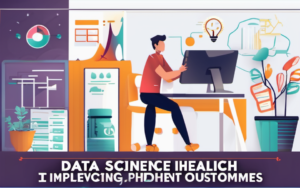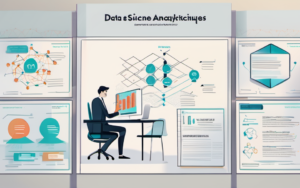In today’s data-driven world, organizations are increasingly leveraging data science to gain a competitive edge. But simply implementing data science strategies isn’t enough. It’s crucial to measure their effectiveness to ensure you’re getting a return on your investment and achieving your desired outcomes. This blog post will explore various methods for measuring the effectiveness of data science strategies, helping you understand the true impact of your initiatives.
Measuring the Impact of Data Science Strategies
Before you can measure the effectiveness of your data science strategies, you need to define what success looks like. This involves identifying clear goals and objectives for each project or initiative.
Defining Success Metrics
Success metrics are specific, measurable, achievable, relevant, and time-bound (SMART) goals that help you track progress and determine the effectiveness of your data science strategies. These metrics should align with your overall business objectives and provide a clear understanding of how your data science efforts contribute to your success.
Key Performance Indicators (KPIs)
KPIs are key metrics that track the performance of your data science strategies and provide insights into their impact. These can be categorized into two main types:
Business-Specific Metrics
These metrics focus on the impact of data science initiatives on key business outcomes. Examples include:
- Revenue growth: How much has your revenue increased due to data science-driven insights and predictions?
- Cost reduction: Have your data science strategies helped you optimize processes and reduce operational costs?
- Customer satisfaction: Has your data science strategy improved customer experience and satisfaction levels?
Data Science-Specific Metrics
These metrics focus on the performance of your data science models and algorithms. Examples include:
- Accuracy: How accurately does your model predict outcomes?
- Precision: How many of the model’s positive predictions are actually correct?
- Recall: How many of the actual positive cases does your model correctly identify?
Data Collection and Tracking
Once you’ve defined your success metrics and KPIs, you need to establish systems for collecting and tracking the necessary data. This involves integrating your data science systems with your existing business intelligence tools or using specialized data visualization platforms to monitor and analyze the data effectively.
Evaluating Model Performance
Evaluating the performance of your data science models is critical to understanding their accuracy and effectiveness. Several metrics are commonly used to assess model performance:
Accuracy and Precision
Accuracy measures how often your model predicts the correct outcome. Precision, on the other hand, measures how many of the model’s positive predictions are actually correct. A high accuracy score indicates that your model is making accurate predictions, while a high precision score indicates that your model is making fewer false positive predictions.
Recall and F1-Score
Recall measures how many of the actual positive cases your model correctly identifies. A high recall score indicates that your model is identifying most of the positive cases. The F1-score combines precision and recall into a single metric, providing a balanced measure of model performance.
ROC Curve and AUC
The Receiver Operating Characteristic (ROC) curve is a graphical representation of the trade-off between true positive rate and false positive rate for different classification thresholds. The Area Under the Curve (AUC) summarizes the performance of your model across all thresholds and provides a single score that represents the model’s overall performance.
A/B Testing and Experimentation
A/B testing is a common approach to evaluate the effectiveness of different data science strategies. By running controlled experiments with different versions of your model or algorithm, you can compare their performance and identify the best approach.
Analyzing Business Outcomes
The ultimate goal of data science is to drive positive business outcomes. To measure the effectiveness of your data science strategies, you need to analyze the impact of your initiatives on your key business metrics.
Revenue Growth and Cost Reduction
Data science can help organizations increase revenue by identifying new opportunities, improving customer targeting, and optimizing pricing strategies. It can also help reduce costs by streamlining operations, automating tasks, and minimizing waste.
Customer Acquisition and Retention
Data science plays a crucial role in improving customer acquisition and retention. By understanding customer preferences and behavior, organizations can develop more targeted marketing campaigns and personalize customer experiences, leading to increased customer acquisition and loyalty.
Operational Efficiency and Process Improvement
Data science can significantly improve operational efficiency by automating tasks, optimizing processes, and reducing bottlenecks. This can lead to increased productivity, faster turnaround times, and improved overall efficiency.
Best Practices for Effective Measurement
To ensure effective measurement of your data science strategies, follow these best practices:
Establish Clear Goals and Objectives
Before you start measuring, it’s crucial to have clear goals and objectives for your data science initiatives. Define what you want to achieve and how you will measure success.
Choose the Right Metrics for Your Needs
Different metrics are relevant for different data science projects. Carefully select the metrics that will provide the most meaningful insights into the effectiveness of your strategies.
Track Data Consistently and Accurately
To get accurate and reliable results, you need to track your data consistently and accurately. Ensure your data collection and tracking systems are robust and reliable.
Communicate Results Effectively
Once you have collected and analyzed your data, communicate the results effectively to stakeholders. Use clear and concise visualizations and reports to present your findings and highlight key insights.
The Importance of Data-Driven Decision Making
Measuring the effectiveness of data science strategies is essential for making data-driven decisions. By understanding the impact of your initiatives, you can make informed decisions about future investments, optimize your strategies, and drive even greater value from your data science efforts.
Continuous Improvement and Optimization
Data science is a dynamic field that is constantly evolving. To stay ahead of the curve, it’s crucial to continuously improve and optimize your data science strategies. Regularly review your success metrics, track your progress, and make adjustments as needed to ensure your initiatives are delivering maximum value.
By following these guidelines and embracing a data-driven approach, you can effectively measure the effectiveness of your data science strategies and unlock the full potential of your data science initiatives.




